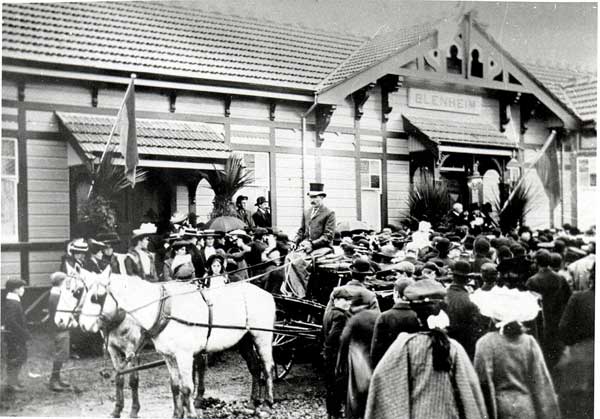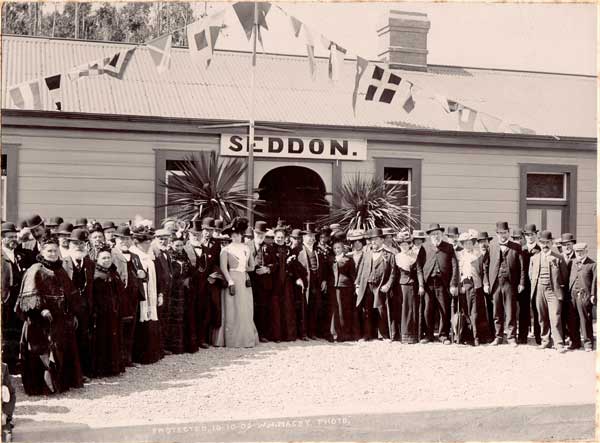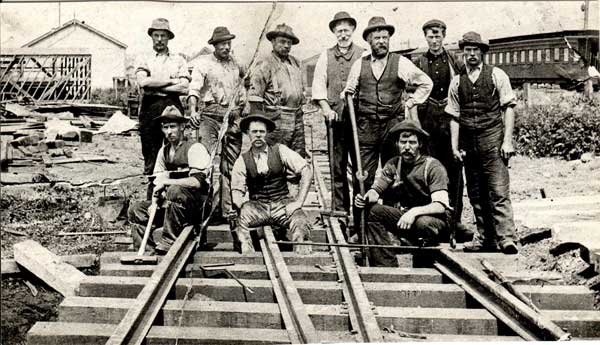Main trunk railway line
Parochialism and politics, the Great Depression and two World Wars meant that completion of the South Island’s Main Trunk Line was a slow, tortuous 75 year journey..
Construction of the South Island Railway: a Stop-Start Journey
Parochialism and politics, the Great Depression and two World Wars meant that completion of the South Island’s Main Trunk Line was a slow, tortuous 75 year journey.1
The early railways in New Zealand—as in most young countries—were designed to rapidly open up the country at a minimum cost.2
The 20 mile line between Blenheim and Picton was opened on November 18, 1875. The line stopped about 1.5 miles (2 km) short of Blenheim until it was extended in 1880/1. In its first financial year, when the line was open for seven and a half months, it carried 15,400 passengers, 6300 tons of goods and 300 head of livestock.3
Between 1874 and 1883, surveys were undertaken to find the best route to link Nelson and Picton with the rest of the South Island. The initial concept was for a railway down the Wairau Valley, joining a main trunk line from Canterbury, with branch lines to Nelson and the West Coast. A Royal Commission decided, however, that a route down the eastern seaboard had the ‘least disadvantages’.4
Throughout the 1880s successive Governments found it increasingly difficult to fund public works. Progress on the Main Trunk Line was slow, with the huge grazing estates of southern Marlborough acting as a disincentive.5 When the Liberal Government came into power in 1891, however, it was determined to break up the large holdings. This led to more intensive settlement, which altered the potential of the land in favour of railway building.6
The Picton Freezing Works opened in 1900, creating a demand for a reliable form of transport from southern Marlborough. Completed in July 1901, the 1065 feet (325 metre) Awatere bridge featured a top deck railway line above a road bridge and spanned the Awatere River for 105 years.7 The Riverlands to Seddon section of the railway was opened on October 10, 1902. There was a four-fold increase in passengers and goods between 1895 and 1910.8 Two historic railway stations, Blenheim and Picton, remain from this era.
The outbreak of World War 1 slowed construction of the line south of Seddon, as men went to war and materials became unobtainable. Work was officially shut down in August 1917 and did not resume until 1928, when construction camps, culverts, fencing and temporary bridges were built.9
It wasn’t long, however, before the effects of the Great Depression saw work on the line cease again in October 1931. By 1935 the economic outlook was brighter and work on the railway resumed, with about 1000 men living in 23 camps strung along the Wharanui-Parnassus section. Wartime manpower and material shortages saw work stop in 1941, only to resume in 1942 when it was decided a railway would conserve petrol and tyres during the war years.10
Plate laying and ballasting bit by bit, the northern and southern sections of the railway drew closer. The final Oaro to Kaikoura section required considerable tunnelling of steep and unstable ground.11
The 348 km Picton to Addington Railway was officially opened on December 15, 1945, a remarkable feat so close to the end of WWII. The longest railway construction project in New Zealand’s history involved laying track, building bridges, tunnels and moving tons of spoil. Hundreds came from Canterbury and Marlborough to the Kaikoura opening, where a plaque was unveiled in memory of eight men killed during construction of the line.12
Nelson’s hopes of a railway connection were revived in the late 1950s, when the second Labour Government, elected in 1957, pursued a 102 kilometre railway linking Nelson and Marlborough. They were dashed in 1960, however, when newly elected National Prime Minister, Keith Holyoake, announced all work on the railway would cease.13
Timeline
[From Picton Chronology compiled for Picton Museum]
1872 - Construction begins of Picton to Blenheim railway line. Work begins at Blenheim end (Contractors, Brogden and Sons)
- 10th July - Brogden and Sons recruit workers from England. The Schielthallion brings immigrants from England to Picton to work on railway construction, 124 men and families. Men engaged for two years at 5/- a day
- 23rd July - First consignment of railway iron arrives in Picton
1875
- 28 April - Picton to Blenheim ends of railway line joined
- 17 Nov - Picton to Blenheim railway official opening. Provincial holiday is declared; engines named Waitohi and Blenheim; civic luncheon at Ship Hotel in Picton; ball in evening; track ends in swamp at Opawa River with Blenheim station on Picton side of Opawa River
1880
- 26 May - Bridge is built across Opawa River and railway line is extended to present site of Blenheim Railway Station. Completed Picton-Blenheim railway opens (approx 70m west of its current location)
1914
- 11 March New (second) Picton Railway Station opens. Transfer of site from Picton Foreshore to bottom of Auckland Street, close to new Waitohi Wharf. First railway platform remains on Picton Foreshore.
2008 (updated 2022)
Story by: Joy Stephens
Sources
- Merrifield, A.L.R. (1990) Beyond Dashwood: a history of the railway in Marlborough. Wellington, N.Z : N.Z. Railway and Locomotive Society, p 53
- Neale, E. (1938) The Heyday of Railway Construction — In New Zealand. The New Zealand Railways Magazine, 13 (4)
- McGavin, T.A. (1977) A Century of Railways in Marlborough. Reprinted from the New Zealand Railway Observer No 146 (Volume 33, No 2, 1976). Wellington : N.Z. Railway and Locomotive Society, p 2-4; Merrifield, p 23
- Churchman, G.(1992). South Island Main Trunk. Wellington, NZ : IPL Books, p 88
- Merrifield, p 28
- New bridge over the Awatere River (Retrieved 2025):
https://www.marlboroughonline.co.nz/marlborough/information/archictecture/bridges/awatere-road-rail-bridge/ - McGavin, p 4
- Merrifield, pp 30, 61-68, 38-39
- Merrifield, p 42
- Merrifield, pp 49, 50-53
- Churchman, p 71
- Churchman, pp 71,78,86
- Merrifield, p 28
Further Sources
Books
- Atkinson, N. (2007) Trainland: How railways made New Zealand. Auckland : Random House
http://www.worldcat.org/oclc/174060648 - Blincoe, Pauline. (1999) Public Works Camps: Poor Kids’ Paradise. Pakawau, N.Z. : P. Blincoe.
http://www.worldcat.org/oclc/154761557 - Churchman, G. & Hurst, T (1992). South Island Main Trunk. Sydney : IPL Books.
http://www.worldcat.org/oclc/29477039 - Churchman, G.B. (1989) The route of the Coastal Pacific Express. Wellington, N.Z. : IPL Books.
http://www.worldcat.org/oclc/82854226 - Kelly, H.D. (1976) As high as the hills: the centennial history of Picton. Whatamango Bay : Cape Catley, pp. 36-41
http://www.worldcat.org/oclc/3241095 - Leitch, D. & Scott, B. (1988) New Zealand Railways : the first 125 years. Auckland : Heinemann Reed
http://www.worldcat.org/oclc/22238095 - McGavin, T.A.. (1977) A Century of Railways in Marlborough. Wellington, N.Z. : New Zealand Railway and Locomotive Society,
http://www.worldcat.org/oclc/153807716 - McIntosh, A.D. (Ed.)(1940;1977) Marlborough: A provincial history. Christchurch, N.Z. : Capper Press.
http://www.worldcat.org/oclc/154763562 - Merrifield, A.L.R. (1990) Beyond Dashwood: a history of the railway in Marlborough. Wellington, N.Z : N.Z. Railway and Locomotive Society.
http://www.worldcat.org/oclc/54297491 - Wright, M.(2003) Rails across New Zealand. Auckland, N.Z. : Whitcoulls.
http://www.worldcat.org/oclc/156039726
Newspapers
- [Where no hyperlink is supplied ask at your local library about full text access to the articles.]
- Andrews, J.(1985) The Picton railway. Journal of the Nelson and Marlborough Historical Societies, 1(5), p.38
http://www.nzetc.org/tm/scholarly/tei-NHSJ04_05-t1-body1-d8.html - Another Section Completed (1911, April 15), Evening Post, p 6
https://paperspast.natlib.govt.nz/newspapers/EP19110415.2.94 - Brehaut, L (2017, July 14) Heritage: The early days of rail in Marlborough. Marlborough Express on Stuff:
https://www.stuff.co.nz/marlborough-express/news/94660386/heritage-the-early-days-of-rail-in-marlborough - Down by the station (1996) Marlborough's Past & Present, 4(2), p.2
- McGavin, R. (1987) The NZR in microcosm: impressions of the main North Line. New Zealand Railway Observer, 44(3), p.16-20
- Lewis, O. (2017, January 24) Earthquake repairs biggest South Island railway project in 'generations'. The Press. Retrieved from Stuff:
http://www.stuff.co.nz/national/88392039/earthquake-repairs-biggest-south-island-railway-project-in-generations - Mahoney, P.(1992) Train time in Marlborough. New Zealand Historic Places, 38: p16-20
- Six Passengers Dead, 36 in Hospital After Train Smash at Blind River (1948, February 25) Marlborough Express, 1866-1966 supplement, p 39
- South Island Railways (1900, September 14), Hawera & Normanby Star, p 3
https://paperspast.natlib.govt.nz/newspapers/HNS19000914.2.23 - South Island Main Trunk (1909, November 29), Hawera & Normanby Star, p 5
https://paperspast.natlib.govt.nz/newspapers/HNS19091129.2.34.2 - The Railways (1920, September 24) Grey River Argus, p 2
https://paperspast.natlib.govt.nz/newspapers/GRA19200924.2.7
Websites
- Awatere Road Rail Bridge 1902 to 2007 [exhibition]. Retrieved 10 November, 2008 from Marlborough Museum:
https://virtualexhibit.marlboroughmuseum.org.nz/mhs/vewebsite1/exhibit4/e40008a.html - Neale, E. (1938) The Heyday of Railway Construction — In New Zealand. The New Zealand Railways Magazine, 13 (4)
http://www.nzetc.org/tm/scholarly/tei-Gov13_04Rail-t1-body-d6.html - Railways (2007). Retrieved from An Encyclopaedia of New Zealand, ed. A. H. McLintock (1966).Te Ara - The Encyclopedia of New Zealand :
http://www.teara.govt.nz/en/1966/railways/1
 Blenheim railway station Marlborough Historical Society - Marlborough Museum Archives
Blenheim railway station Marlborough Historical Society - Marlborough Museum Archives Opening of the Blenheim-Seddon railway. Marlborough Historical Society - Marlborough Museum Archives
Opening of the Blenheim-Seddon railway. Marlborough Historical Society - Marlborough Museum Archives Railway workers about 1913 Marlborough Historical Society - Marlborough Museum Archives
Railway workers about 1913 Marlborough Historical Society - Marlborough Museum Archives